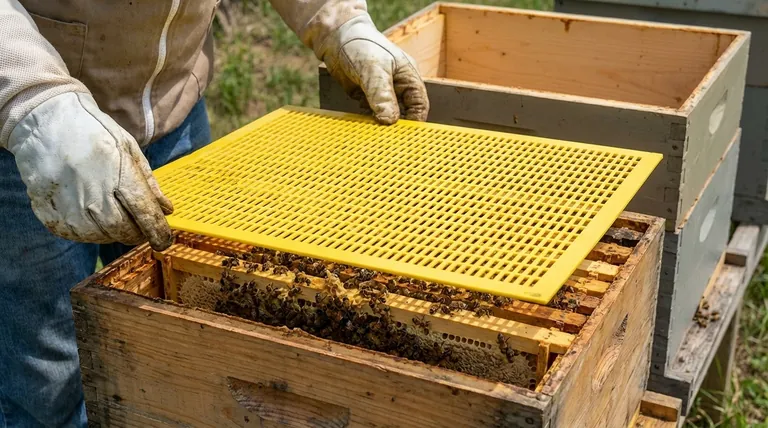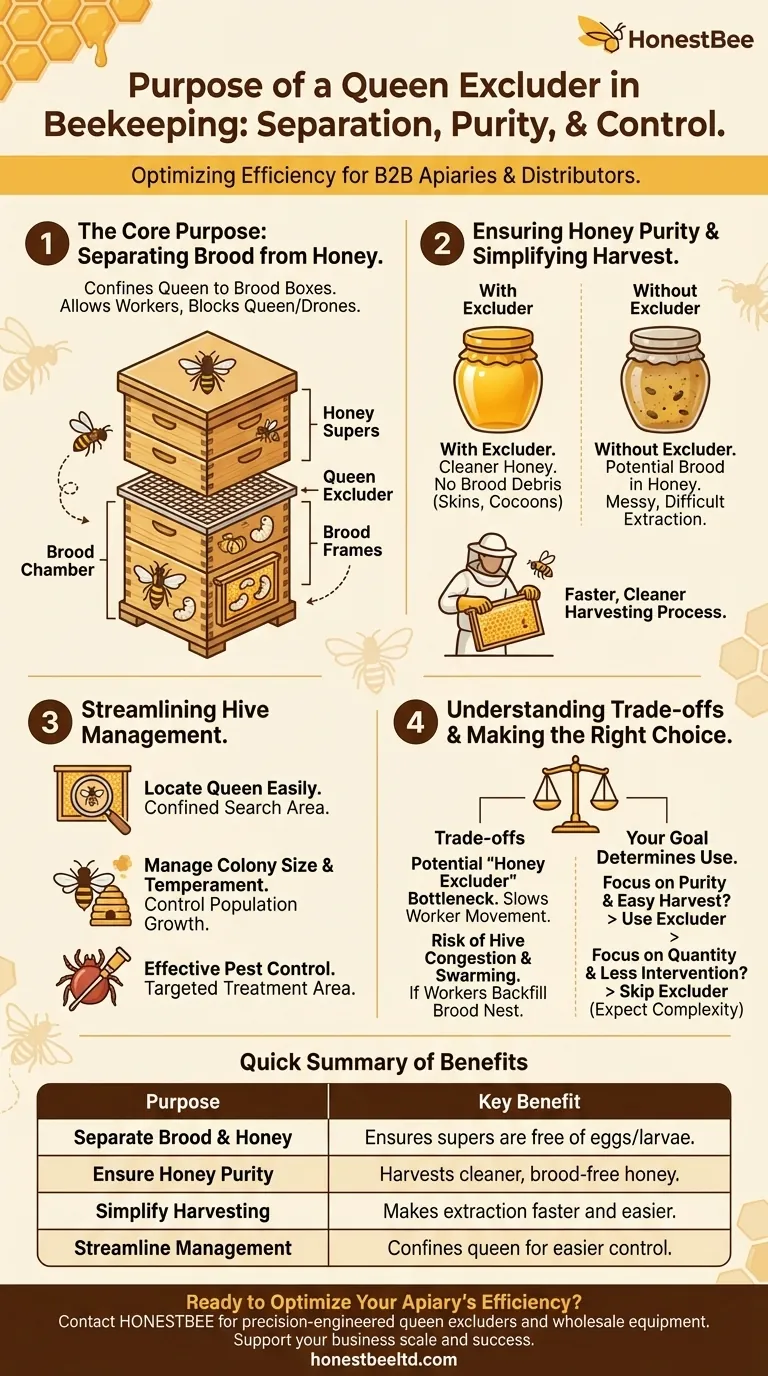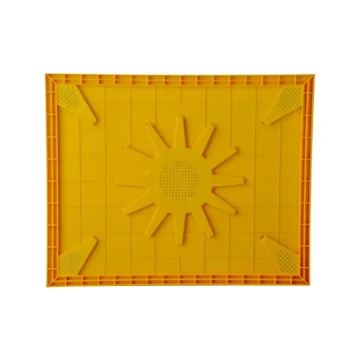In beekeeping, a queen excluder is a tool of separation and control. Its primary purpose is to confine the queen bee to the lower sections of the hive, known as the brood boxes. This simple grid, with slots large enough for worker bees but too small for the queen, prevents her from laying eggs in the upper boxes, or "honey supers," which are reserved exclusively for honey storage.
A queen excluder is less about restricting the queen and more about ensuring honey purity and simplifying hive management. By creating a physical barrier between the brood nest and the honey stores, beekeepers can harvest cleaner honey and manage their colonies with greater efficiency.

The Core Purpose: Separating Brood from Honey
The most significant benefit of a queen excluder is its ability to create a clear division of labor within the hive structure, separating the nursery from the pantry.
What is a Queen Excluder?
A queen excluder is a flat screen or grid made of metal or plastic. The openings are precisely engineered to allow smaller worker bees to pass through freely while blocking the larger queen and drones from moving into the upper parts of the hive.
Ensuring Honey Purity
When a queen lays eggs in honey frames, the resulting brood cycle leaves behind shed skins, cocoons, and waste. This can darken the wax and affect the final honey product.
By keeping the honey supers brood-free, beekeepers ensure the honey harvested is as pure as possible, free from the debris associated with hatched bees.
Simplifying Honey Harvest
Harvesting honey from frames that contain eggs, larvae, or pupae is difficult and messy. Beekeepers must take care not to harm the developing bees.
Using an excluder means the honey supers contain only honey. This makes the entire process of removing frames and extracting honey faster, cleaner, and less stressful for both the beekeeper and the bees.
Streamlining Hive Management
Beyond honey purity, the excluder is a powerful tool for making the entire beekeeping process more predictable and manageable.
Locating the Queen with Ease
Finding one bee among tens of thousands can be a monumental task. A queen excluder narrows the search area dramatically.
When a beekeeper needs to inspect, mark, or replace a queen, they know she is confined to the one or two brood boxes below the excluder, saving significant time and effort.
Managing Colony Size and Temperament
In some situations, particularly with highly defensive or aggressive colonies like Africanized bees, limiting the queen's laying space can help control population growth.
A smaller brood nest can result in a smaller, more manageable, and less defensive colony, which is a critical safety and management consideration in certain regions.
A Potential Tool for Pest Control
The varroa mite, a devastating parasite, reproduces within the hive's brood cells. Some management strategies rely on concentrating the brood in a specific area.
An excluder helps ensure the brood is contained within the brood boxes, which can make varroa mite treatments and population monitoring more effective.
Understanding the Trade-offs
While highly useful, the queen excluder is not without its controversies and potential downsides. Its use is a frequent topic of debate among beekeepers.
The "Honey Excluder" Debate
Some beekeepers believe that the physical barrier, even though workers can fit, can slow down their movement into the honey supers.
This potential bottleneck has led some to call it a "honey excluder," arguing that it may reduce the colony's overall honey production by creating an obstacle course for foraging bees.
Potential for Hive Congestion
If workers are hesitant to pass through the excluder, they may begin storing nectar in the brood chamber instead of the supers. This is known as "backfilling."
A congested brood nest leaves the queen with no room to lay, which is a primary trigger for the colony to swarm (when the old queen leaves with half the bees to find a new home).
Making the Right Choice for Your Goal
Deciding whether to use a queen excluder depends entirely on your beekeeping philosophy and objectives.
- If your primary focus is maximum honey purity and easy harvesting: Using a queen excluder is the most reliable method to keep your honey supers clean and your extraction process simple.
- If your primary focus is maximizing honey quantity and you prefer less intervention: You may choose to operate without an excluder, but be prepared for more complex inspections and potential brood in your honey frames.
- If you are managing aggressive bees or implementing specific pest controls: An excluder is an invaluable tool for controlling the queen's laying area and, by extension, the colony's dynamics.
Ultimately, the queen excluder is a strategic instrument that empowers you to manage your hive in a way that aligns with your specific goals.
Summary Table:
| Purpose | Key Benefit |
|---|---|
| Separate Brood & Honey | Ensures honey supers are free of eggs and larvae. |
| Ensure Honey Purity | Harvests cleaner honey, free from brood debris. |
| Simplify Harvesting | Makes honey extraction faster, cleaner, and easier. |
| Streamline Management | Confines the queen for easier inspection and control. |
Ready to Optimize Your Apiary's Efficiency and Honey Quality?
As a commercial beekeeper or equipment distributor, maximizing hive productivity is your priority. HONESTBEE supplies the durable, precision-engineered queen excluders and beekeeping equipment you need to achieve pure honey harvests and simplified hive management. Our wholesale-focused operations are designed to support your business's scale and success.
Contact HONESTBEE today to discuss your wholesale supply needs and elevate your beekeeping operation.
Visual Guide

Related Products
- Professional Plastic Queen Excluder for Modern Beekeeping
- Wooden Queen Bee Excluder for Beekeeping
- Premium Wood Framed Metal Wire Queen Bee Excluder
- Metal Queen Bee Excluder for Beekeeping
- High Performance Plastic Queen Excluder for Beekeeping and Apiary Management
People Also Ask
- What is a Queen Excluder and how does it work? Achieve Purer Honey & Better Hive Control
- What is the primary function of a queen excluder in beekeeping? Control Hive Layout for Efficient Honey Harvesting
- How does a queen excluder work? Master Hive Management for Pure Honey Harvests
- What are the main advantages of using a queen excluder in beekeeping? Simplify Hive Management & Harvest
- Why are queen excluders recommended for Flow Hives? Prevent Brood Damage for a Clean Harvest



















